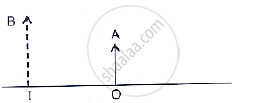Advertisements
Advertisements
प्रश्न
A convex lens forms an image of an object equal to the size of the object. State two more characteristics of the image.
उत्तर
The image formed is real and inverted.
APPEARS IN
संबंधित प्रश्न
What type of lens is shown in the diagram on the right? What will happen to the parallel rays of light? Show by completing the ray diagram.
A convex lens has a focal length of 10 cm. At which of the following position should an object be placed so that this convex lens may act as a magnifying glass?
(a) 15 cm
(b) 7 cm
(c) 20 cm
(d) 25 cm
A convex lens of focal length 0.10 m is used to form a magnified image of an object of height 5 mm placed at a distance of 0.08 m from the lens. Calculate the position, nature and size of the image.
Complete the following sentence.
A long-sighted person cannot see ........... objects clearly. Long-sightedness can be corrected by using .............. lenses.
The focal length of a thin convex lens is ______ than that of a thick convex lens.
The given below figure shows an object OA and its image IB formed by a lens. State three characteristics of the image.

A teacher sets up the stand carrying a convex lens of focal length 15 cm at 42.7 cm mark on the optical bench. He asks four students A, B, C and D to suggest the position of screen on the optical bench so that a distinct image of a distant tree is obtained almost immediately on it. The positions suggested by the students were as
A. 12.7 cm
B. 29.7 cm
C. 57.7 cm
D. 72.7 cm
The correct position of the screen was suggested by
(a) A
(b) B
(c) C
(d) D

i. Which type of microscope has the arrangement of lenses shown in the adjoining figure?
ii. Label the figure correctly.
iii. Write the working of this microscope.
iv. Where does this microscope used?
v. Suggest a way to increase the efficiency of this microscope.
Yesh find out F1 and F2 of symmetric convex lens experimentally then which conclusion is true.
State the nature and position of the object on the principal axis to obtain a real image of the same size
